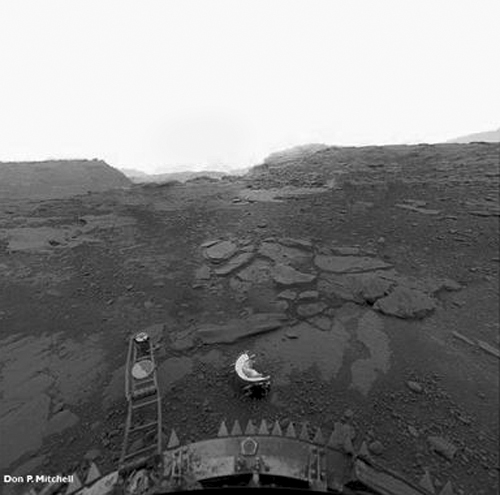
It’s hard to imagine, with its pressure-cooked 800º baked-rock surface, but Venus may have once had oceans, suggests data from the European Space Agency’s Venus Express orbiter.

Extensive infrared mapping of Venus’ southern hemisphere shows large areas of rock that appears to be granite. Granite, as we know it on Earth, is formed when basalt is pushed down below the crust by tectonic actions, mixed with water and then brought back to the surface by volcanic activity. There it hardens into granite….the main building blocks of the continents.
Granite radiates heat at specific wavelengths, as do all materials, and Venus Express’ spectrometer has charted these different radiations from orbit. The data was then assembled into a comprehensive map of the southern half of the planet. The findings hint at the past life of Venus….one with volcanic activity, continental movements, and possibly even oceans like ours.
“If there is granite on Venus, there must have been an ocean and plate tectonics in the past.”
Venus is structurally very similar to Earth. Same basic size, same rocky composition, similar gravity… similar distance from the sun.But Venus is now wrapped in a much denser carbon dioxide atmosphere, holding in the sun’s heat and literally both baking and crushing the surface with heat and pressure. The existence of water there now is impossible, but it may not have always been the case. This is what the infrared map is telling us.
Venus is important to study because it is so similar to our own planet. Is Venus what Earth may one day become? Is Earth what Venus may have once been? At one time the two worlds were probably identical, yet went down very different paths. Luckily for us our planet became what it did. But it is important to investigate the alternative result too… after all, the story’s not over yet.
Image credit: ESA/MPS/DLR/IDA. Venera-13 image remapped by Don P. Mitchell.
This is fascinating, but also a little frustrating. I’ve always thought that if Mars was probably once much more Earth-like, maybe even alive, then there’s no reason that Venus might not have been the same way, albeit with a very different outcome eventually. In other words, if you can imagine the possibility of fossils hiding somewhere in Martian rock, couldn’t you say the same thing about Venus? The frustrating part is that it’s hard enough to work on Mars–I doubt I’ll ever see an exploration of the surface of Venus in my lifetime.
LikeLike
Probably not Bill…I have to admit I wouldn’t want to be the first guy to try to wander around Venus. But it stands to reason that if Venus – maybe even more so than Mars – ever had oceans it may have provided a foothold for life.
Although, if it had developed life, it probably wasn’t the plant life that Earth had or else it wouldn’t have gotten so out-of-hand with the CO2. Maybe. Who knows.
So many unanswered questions, right in our own backyard. It IS frustrating!
LikeLike
Something tells me that Venus was once very Earth like but early in it’s history took a pretty violent hit from a huge comet/asteroid which stirred up the planets Volcanism, burned the planet and evaporated the Oceans and the planet has never recovered. Mars probably took a huge hit like Venus and never recovered. It all has to do with the core, Earth can take hits but our core saves us and the planet heals. On smaller planets like Mars and Venus, it really did change them forever.
LikeLike
Years ago, Carl Sagan had postulated seeding Venus clouds with blue green algae to terraform the planet, and to bombard its surface with comets to give Venus a spin and water. I am wondering with what we have learned about Venus since that time, if terraforming the planet is something we could ever achieve. I have always thought that the amount of comets needed to slam into the planet to give it oceans and a spin would be immense to the degree it would liquify its surface. Thoughts?
LikeLike
I doubt water would last long on the 800º+ F surface of Venus, barely long enough to boil off instantly into the atmosphere to add to its already crushing density and possibly make the sulfuric acid clouds even more caustic. And it’s thought that Venus got slammed hard with something in its past already…hard enough to give it a reverse spin on its axis. If there’s a world in our solar system open to “terraforming”, it would most likely be Mars. Venus, although Earth-sized and nearby, is just too hostile to life.
LikeLike
Venus is not a “similar distance from the sun” as the earth. It also has a much thicker atmosphere, with pressures being about 90 times greater at the surface. The greater the atmospheric pressure, the higher the temperature.
LikeLike
I would count Venus as being “relatively” a similar distance from the Sun as Earth. Closer, yes, but not so close as to solely account for the incredibly high surface temps. That’s all from the greenhouse effect of the dense, cloudy atmosphere.
I’m not sure how much the pressure has to do with the temperature either. Yes, 90 times sea level on Earth…deadly to humans, clearly. But the heat is caused by the trapped solar energy, unable to radiate back out into space because of the impenetrable carbon dioxide cloud cover. More here on this post: https://lightsinthedark.wordpress.com/2009/04/07/but-what-about-venus/.
LikeLike
SI !!!!!!!11 MA SE INVECE FOSSE ABITATA IN UN ALTRA DIMENSIONE PARALLELA.. IO INVECE NE SONO CONVINTO PERCHE’ GIORGE ADAMSKI PADRE DELL’UFOLOGIA SCRIVE IN DIVERSI LIBRI CHE ERA IN CONTATTO CON ALIENI PROVENIENTI DA VENERE E NE FOTOGRAFO’ I LORO MEZZI DI TRASPORTO O MACCHINE DEL TEMPO, I COSI’ DETTI (DISCHI VOLANTI)
LikeLike